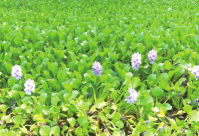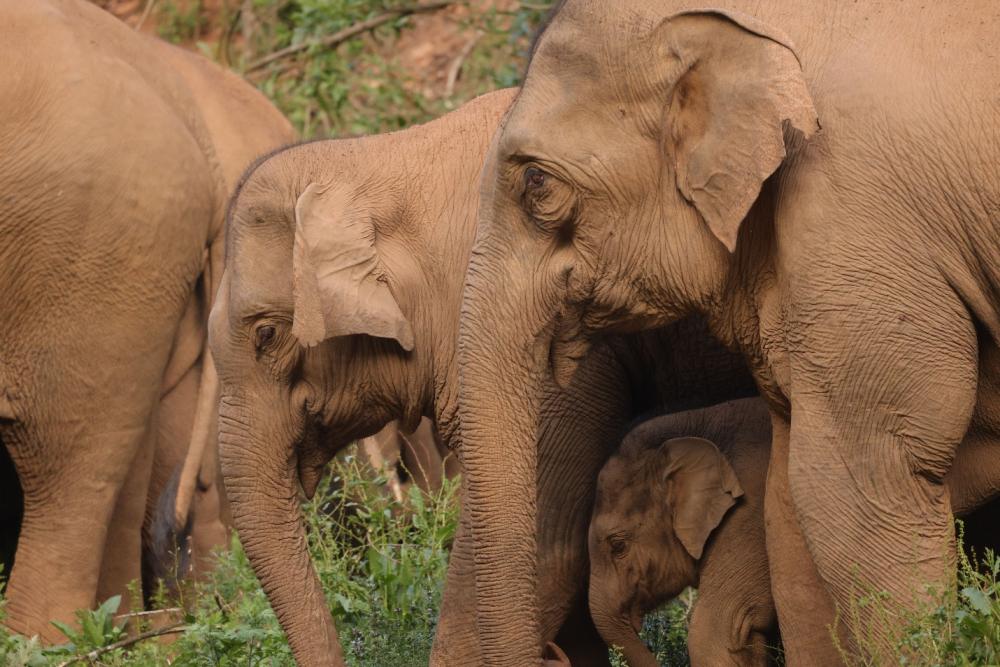It is even more important to seek ways to coexist with them, and identifying and understanding are not the ultimate goal. For the invasion of diverse species in nature, species identification
In July 2021, Teacher Ran Hao proposed the idea of writing a book about invasive species to fulfill his long-standing wish. More than a decade ago, he began to pay attention to the phenomenon of biological invasion. At that time, he was doing a program with a certain media and privately asked the director if he had any intention of doing such a topic, but was rejected by the director, citing "fear of causing panic.". Teacher Ran Hao is very puzzled by this. He believes that science popularization can eliminate panic, and avoiding it may actually promote public misconceptions, which is also the reason for the birth of "Species Invasion".
This is already the third book that I have collaborated with Teacher Ran Hao on. The first two books are Animal Kingdom and Silent Micro World, respectively. What Species Invasion wants to tell us more is that invasive species are only a part of this diverse natural species, living together with us humans on this planet. Identifying and understanding is not the ultimate goal, but rather finding a way to coexist with them.
The water hyacinth, also known as the water hyacinth or water hyacinth, is native to the tropical regions of America.
"The first draft of 'resurrection from death'"
I thought "Invasion of Species" might be a highly specialized and difficult to read book, and this topic may not receive much attention from ordinary people, with only academic discussions. But after receiving the first draft, I was still moved by the interesting content, concise writing, and charming story.

Speaking of submitting the initial draft, I have to talk about an interlude here. In March 2022, when Teacher Ran Hao was about to finish his work, he suddenly sent me the following words on WeChat: "My mentality has collapsed." It turned out that the storage disk that Teacher Ran bought had a problem, and the computer could not recognize it, resulting in the loss of all recent data... including the electronic manuscript and images of this book.
You can imagine how shattered Teacher Ran's heart was at that moment. But he quickly sorted out his mood and began the work of saving the first draft. Fortunately, Teacher Ran had previously printed a paper manuscript, which had been painted in a mess by her son, but at least it was salvaged and the rest was just pictures. About a week later, Teacher Ran told me that with his efforts, the pictures were basically retrieved. After experiencing twists and turns, Teacher Ran became more cautious in dealing with text and images.
The next step is to include it in the publication plan and start the review work. I have long admired Teacher Ran's level of seriousness towards the manuscript. During the waiting period for scheduling, he continuously revised and sent several revised drafts. After the review work began, we also discussed many detailed issues: which terminology is more appropriate, which data does not match, and which wording needs to be modified.
One of the data modifications left a deep impression on me. The book directly cites data from the Red List of Endangered Species released by the World Conservation Union: "Among the 5743 species of amphibians in the statistics, 1856 are in endangered status, accounting for 32.5%, significantly higher than the proportion of birds and mammals; at least 43.2%, which is 2468 species of amphibian populations, are experiencing some degree of decline..." However, upon careful calculation, 32.5% of 5743 should be 18665743, 43.2% of which is 2481. If we believe that the numbers 1856 and 2468 are correct, they account for 32.3% and 43.0% of 5743, respectively. After reviewing the original English file, it was found that the numbers did not match. At this point, the question arises: is it based on the number of species or the percentage? Which part of the original data is most likely to be miscalculated? After giving feedback on this issue to Teacher Ran, based on professional research experience, Teacher Ran believes that there is little possibility of errors in the number of species, and it is highly likely that there was an error in the later calculation of the proportion. So, in the end, we decided to adopt a combination of "1856", "32.3%", and "2468" and "43.0%".
"The title of the book 'Fearless of Risk'"

While reviewing the manuscript, we are also discussing the concept of book title and cover design. The discussion about book titles has always been a tug of war between our side and Teacher Ran Hao in the early stages. Teacher Ran hopes to use names such as "invasive species" and "species invasion", but we consider factors such as market acceptance and channels' ability to capture sensitive words. We do not recommend using the term "invasion" because it appears to be highly aggressive and ordinary readers may have resistance. Under our strong insistence, Teacher Ran seems to have loosened up. After thinking about more than a dozen book titles but unable to reach an agreement, we once wanted to use the name "alien species".
The adult of the American leaf miner. They are small in size, only 1.3-2.3mm, with females slightly larger than males.
But in fact, the concepts of "alien species" and "invasive species" are different. Alien species are not necessarily invasive species, and the impact of some alien species is positive. I would like to express my sincere gratitude to Professor Zhang Jinshuo from the National Zoological Museum for his valuable feedback on the title of the book. After discussing the content of the manuscript with Professor Ran, he pointed out that many alien species are of great help to humans, and even human survival relies on them. But if there is a trend of invasive alien species, that is another matter. The theme of this book is obviously about the phenomenon of invasion, and the core word is not alien species, but invasion. Therefore, Teacher Ran still insists on using "species invasion" directly, not avoiding it, and telling directly is his consistent style. When our thinking is limited by market acceptance, we tend to overlook the rigor of the book title itself. From the title of the book, it can also be seen that science, rigor, and accuracy are always above all else for a popular science book.
"Invasive species coexisting with it"
Although this book is called "Species Invasion," you won't be able to read the aggression and threat displayed in the title. It's more about the silent game between various species, the environment, and humans. Indeed, many exotic species have caused damage to the environment and brought some impact on people's lives, but it is undeniable that there are also many "unknown" invasive species around us, even beloved by people, such as tilapia in the dinner plate, delicious crayfish, water hyacinth in the fish tank, and Dracaena sanderiana in the vase. If they are spread in the wild, they are all first-class invasive species. Do we feel panicked when facing a plate of tomato sauce tilapia or spicy crayfish? Definitely not.

The fruit fly is harmful to fruits.
In the author's opinion, most invasive species will not have a significant impact on everyone's life. Even species like the red fire ant, which may directly harm humans, are not often bitten by people in epidemic areas, and only a very small number of people experience allergic reactions. In fact, we are living with many invasive species. For example, the most common ant is almost invisible on the streets of many cities. Most of them are invasive species, and even foreign ants have been replaced several times.
A few years ago, I found rampant ants in a house in my hometown in Northeast China. These ants are small in size, yellow brown in color, and usually appear under the kitchen countertop. Spraying pesticides can prevent them for a while, but soon they will make a comeback, which is very annoying. After reading Teacher Ran Hao's initial draft, I can basically confirm that this is probably Pharaoh Ant. This type of ant is very common in China, with typical characteristics of being very small, penetrating everywhere, and having a keen sense of smell. It is often hidden in luggage, wardrobes, or cabinets, but you cannot demolish walls or lift floors for it, because the few worker ants you see moving out are meaningless to kill. Even if you are lucky enough to find their nest and carry out local cleaning, it may still be in vain - perhaps there is still a part of the nest of ants you are facing in your neighbor's house, and as long as there are a few eggs and worker ants present, these ants will soon produce new breeding ants, and after a few months, they will become vibrant again. After learning the truth about the ants in the kitchen, I felt a little relieved. Since I couldn't stop killing them, I decided to spray them regularly and coexist with them.
When it comes to popular invasive species, one cannot help but mention crayfish. In this book, the author transforms into a chef and elaborates on the processing and cooking methods of crayfish. Who would have thought that a popular science book about invasive species would still have a recipe?
Although crayfish are delicious, if scattered in the wild, it can have a very serious impact on agriculture and water conservancy facilities, and cause great ecological damage. It not only threatens the survival of amphibians, but also competes with local Chinese mitten crab and green shrimp species, and its competitiveness is stronger, squeezing the ecological space of local shrimp and crab.

Can we protect the environment and maintain ecological balance by eating? This is probably a bit wishful thinking. Because most of the crayfish we eat are not wild, but farmed. And because the current crayfish farming industry continues to grow, it has actually increased the risk of escape. The author mentioned that with the increasing popularity of crayfish among consumers, the individual output value of crayfish in China has reached 79.1 billion yuan in 2020, becoming a pillar industry in many regions. So, trying to control the quantity of crayfish by eating may be counterproductive.
"Improper release can easily lead to" killing "."
For invasive species, ordinary people have very limited abilities beyond knowing and adapting to them. It should be noted that we should not attempt to control them. I increasingly believe that reducing human intervention is actually the most important thing in the face of nature, and the most serious intervention that ordinary people may have against nature is to release it.
The act of releasing animals has a long history in China, based on people's simple and compassionate emotions, and is an excellent quality of our nation. Buddhism particularly advocates the act of releasing oneself, advocating that releasing oneself can accumulate merits and bring blessings, but releasing oneself should be scientific. Improper release may cause the proliferation of invasive species and disrupt local ecological environments. We often read about the serious ecological hazards caused by improper release in the news, resulting in huge economic losses and even potentially causing personal harm to other people. Release victims also face the consequences of punishment.
But this book also mentions a point that I once overlooked, which is that improper release can lead to overuse and damage to animal resources. For example, no one used to catch magpies, but now that there are more people releasing magpies, there is a practice of catching and selling magpies. Bird research expert Liu Huili once bluntly said, "Every time you see a live released bird, there are more corpses behind it, which means that a large number of birds die in the process of sticking to the net and transportation. A researcher told me that behind one released bird, there are 20 corpses." This is somewhat ironic. The original intention was to release, but the result has spawned a "killing" industry chain, with goals and results going against each other.

Canadian yellow flower.
As an editor, I always believe that the first priority is to present good works to readers, let excellent authors enter the public eye, and guide and disseminate correct values.
For an excellent author like Teacher Ran Hao, I am afraid of being let down, afraid that few people will know about him, afraid that his works will not be read by many, and afraid that due to my own reasons, my excellent works will be delayed. Although gold always shines, in my opinion, late shining does not count as shining. If excellent works and authors take many years to be recognized, it is a loss for people.
"Species Invasion" by Ran Hao, published by CITIC Publishing Group




